Climate Change
This is an archived version. Please see our current page on the Climate Crisis Impact on Amphibians.
Originally posted on February 22, 2006 by Vance Vredenburg; updated M. McDonald and T. Sayre, 14 May 2008.
This is an archived version. Please see our current page on the Climate Crisis Impact on Amphibians.
Originally posted on February 22, 2006 by Vance Vredenburg; updated M. McDonald and T. Sayre, 14 May 2008.
Several accounts of declining amphibian populations have been from relatively pristine areas such as designated wilderness areas and national parks (Pounds and Crump 1994, Lips 1998, Lips et al. 2006). In these areas, global climate change may be directly and indirectly responsible for declines (Donnelly and Crump 1998, Pounds et al. 1999). Extinctions and extirpations of Mountain Yellow-Legged Frogs in California, and Harlequin Frogs and Golden Toads in highland Costa Rica are the subject of inquiry into climate linked declines (Wake 2007). For example, one study suggests that global climate change has made conditions more favorable for a new disease (chytridiomycosis) thus indirectly leading to extinctions and declines of amphibians(Pounds et al. 2006); however another study contests this and suggests that the disease spread and associated species extinctions do not require a change in climate to explain the emergence and spread of the disease (Lips et al 2006, Lips et al. 2008). Direct consequences of climate change can also be expected because amphibians may be more sensitive to climate change than other species. Because of their permeable skin, biphasic lifecycles and unshelled eggs, amphibians are extremely sensitive to small changes in temperature and moisture (Carey and Alexander 2003). Here we summarize some of the evidence that climate change has directly and indirectly affected amphibian populations around the world.
Global warming and amphibian breeding phenology
The timing of amphibian breeding is largely driven by environmental cues such as temperature and moisture (Carey and Alexander 2003); because of this, their breeding phenology may be directly affected by global warming. Amphibians in temperate regions may be even more susceptible to increases temperatures. Most temperate species spend a large portion of the year inactive, escaping either cold winters or hot summers. Subtle increases in temperature or moisture trigger them to emerge from their hibernacula. Immediately upon emergence, they migrate to ponds or streams to breed. Thus, one hypothesized direct affect of global warming on amphibians is a trend towards early breeding as the average temperatures increase. If amphibians breed too early in the season they may be more vulnerable to early snowmelt induced floods and early season freezes that are usually less common later in the season. To test his hypothesis, researchers from Europe and North America have analyzed long-term data sets looking for trends towards earlier breeding. Some amphibians do show a trend towards earlier breeding but not all species do (Beebee 1995, Blaustein et al. 2001, Gibbs and Breisch 2001). In addition, this trend may vary regionally for a single species. For example, the spring peeper (Pseudacris crucifer) is breeding earlier in Ithaca, New York, in the 1990ís than it did in 1900ís (Gibbs and Breisch 2001) but does not appear to be breeding earlier in Germfask, Michigan (Blaustein et al. 2001). In the table below, we list the amphibians in North America and the United Kingdom that are showing a trend towards earlier breeding and those that are not breeding earlier based on studies from Beebee 1995, Blaustein et al. 2001 and Gibbs and Breisch 2001 (table modified from Blaustein et al. 2003).
| Species |
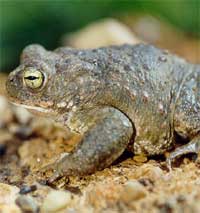
Natterjack toad Epidalea calamita © 2000 Arie van der Meijden |
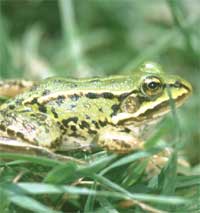
Edible frog Pelophylax esculentus © 2000 Arie van der Meijden |
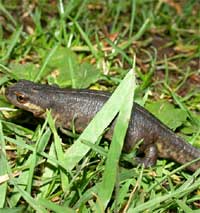
Palmate newt Lissotriton helveticus © 2002 John P. Clare |
| Where: | Hampshire, England | Sussex, England | Sussex, England |
| Reference: | (Beebee 1995) | (Beebee 1995) | (Beebee 1995) |
| Species: |
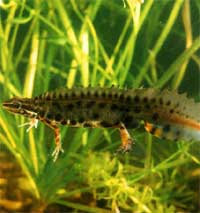
Smooth newt Lissotriton vulgaris © PENSOFT Publishers |
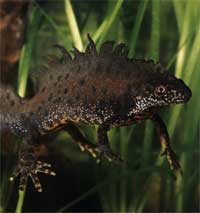
Great-crested Newt Lissotriton cristatus © PENSOFT Publishers |
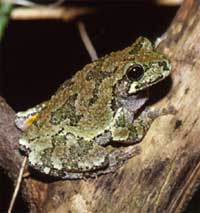
Grey treefrog Hyla versicolor © 1998 Joyce Gross |
| Where: | Sussex, England | Sussex, England | Ithaca, New York, USA |
| Reference: | (Beebee 1995) | (Beebee 1995) | (Gibbs and Breisch 2001) |
| Species: |
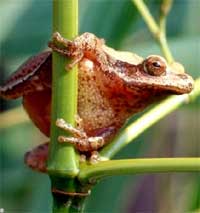
Spring Peeper Pseudacris crucifer © 2001 John White |
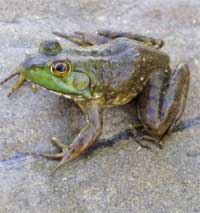
American bullfrog Rana catesbeiana © 2002 William Flaxington |
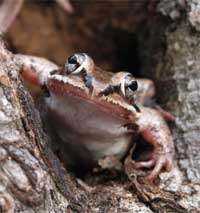
Wood Frog Rana sylvatica © 2003 John White |
| Where: | Ithaca, New York, USA | Ithaca, New York, USA | Ithaca, New York, USA |
| Reference: | (Gibbs and Breisch 2001) | (Gibbs and Breisch 2001) | (Gibbs and Breisch 2001) |
Amphibians not breeding earlier
| Species: |
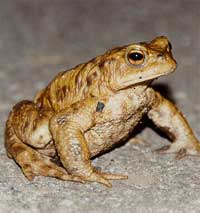
Common Toad Bufo bufo © 2000 Arie van der Meijden |
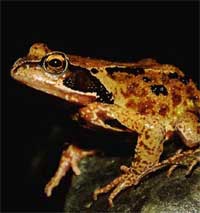
Common Frog Rana temporaria © 2003 Twan Leenders |
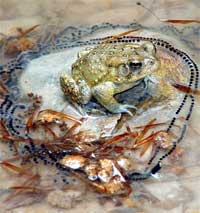
American Toad Bufo americanus © 2003 Brad Moon |
| Where: | Purbeck Hills in south Dorest, England | Sussex, England | Ithaca, New York, USA |
| Reference: | (Reading 1998) | (Beebee 1995) | (Gibbs and Breisch 2001) |
| Species: |
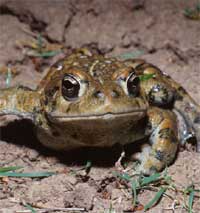
Western Toad Bufo boreas © 2000 Joyce Gross |
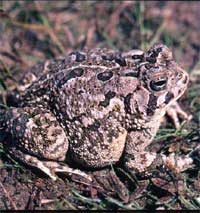
Fowler's toad Bufo fowleri © 1979 Alan Resetar |

Spring Peeper Pseudacris crucifer © 2001 John White |
| Where: | Lost Lake, Three Creeks and Todd Lake, Oregon, USA | Long Point, Ontario, Canada | Germfask, Michigan, USA |
| Reference: | (Blaustein et al. 2001) | (Blaustein et al. 2001) | (Blaustein et al. 2001) |
| Species: |
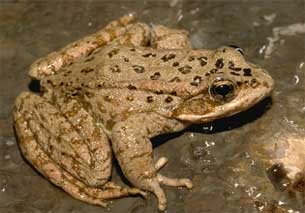
Cascades Frog Rana cascadae © 1998 Harry Greene |
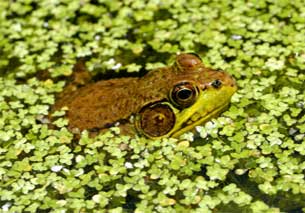
Green Frog Rana clamitans © 2003 John White |
| Where: | Site One and Todd Lake, Oregon, USA | Ithaca, New York, USA |
| Reference: | (Blaustein et al. 2001) | (Gibbs and Breisch 2001) |
Direct effects of climate change on amphibians
To date, there is limited data available to answer questions concerning the effects of climate change on amphibians and most of the data that exists are for relatively short time periods, but hopefully, with monitoring programs in place all over the world, we will have more data to better answer question associated with amphibian declines and climate change. However, even with large data sets, it is difficult to determine causal relationships, because other environmental factors vary concurrently. Carey and Alexander (2003) suggest that to make this link, several steps must be followed including the requirement that studies be made into the future, as opposed to the predominant method for studying climate changes that involves looking at existing datasets. The article states the importance of considering indirect effects of climate change, including breeding cycles, disease, and other environmental factors.
A handful of studies, mostly from the tropics, have analyzed available data, and have found casual relationships between declines and irregular climate conditions. In Brazil between 1979 and 1982, Heyer et al. (1988) found that sever frosts correspond to the extinction of five frog species. Also, Brazil, Weygoldt (1989) found that other declines were associated with dry winters. In eastern Australia, Ingram (1990) and Laurance (1996), both found a correlation between drought and massive declines of stream-dwelling rain forest amphibians. In North America, Corn and Fogleman (1984), found a correlation between the extinction of montane populations of the northern leopard frog, Rana pipiens and drought. In Puerto Rico, Stewart (1995) found that the dramatic population declines in 1983 of the Puerto Rican coqui, Eleutherodactylus coqui, and other Puerto Rican frog species corresponded to an increased number of extended dry periods (i.e. multiple consecutive days with less than 3mm of rainfall). In other words, it was the length of dry periods that had noticeably increased instead of an overall decrease in the annual precipitation. Finally, in the cloud forests of Monteverde, Costa Rica, Pounds et al. (1999 and 1994) found a correlation between the pattern of dry mist frequency associated with highland forests and the decline and likely extinction of several species of amphibians, including the popular golden toad, Bufo periglenes, the poster child for amphibian declines. More recently Pounds et al. (2006) report amphibian declines following regional warming periods.
Indirect effects of climate change on amphibians
It is likely that climate change is affecting amphibian populations in subtle and more complex ways. For example, local changes in the environment can decrease immune function and lead to pathogen outbreaks and elevated mortality. Or conditions can change to become more favorable for growth of a pathogen. For example, the chytrid fungus (Batrachochytrium dendrobatidis ) grows best in culture between 6-28 degrees C (Bradley et al 2002) and dies at 32 degrees C (Berger 2001). A recent laboratory study done by Gervasi et al. (2008) investigated changes in amphibian metamorphosis time due to pond desiccation and whether amphibian immune system become compromised as a result these changes. They found that amphibian immune responses became increasingly weaker and leucocyte counts were increasingly lower with higher desiccation. These results suggest that a trade-off exists whereby rate of metamorphosis increases under desiccation conditions, allowing for survival. This also supports the view that climate effects are involved in weakened immune systems making it more difficult for amphibians to fight off diseases such as chytrid fungus. In Costa Rica, Pounds et al (2006) also report that global warming is leading to warmer nighttime temperatures and mistier daytime temperatures, resulting in a better growth spectrum for B. dendrobatidis . Here, data is used from a study (La Marca et al. 2005) cataloguing the declines and disappearances of 22 species of Atelopus (harlequin frogs) from 1967 through 2004 (Pounds et al. 2006 study uses data through 1998). Last year observed (LYO) data is used to make links between declines and extinctions and both climate change and chytridiomycosis. Controlling for the effects of altitude shows that the declines and extinctions are occurring in protected areas where habitat loss is not a factor.Lips et al. (2008) challenge the idea that there is a link between climate change and chytridiomycosis, suggesting that there is no evidence of a climate - chytridiomycosis epidemic link, but rather that the epidemics can be explained by introduction events and subsequent rapid spread. The authors examine population decline data and Batrachochytridium dendrobatidis information to show that the chytridiomycosis epidemic in Central and South America can be strongly modeled based on date of decline (DOD) instead of last year observed (LYO).
Or the situation can be even more complex, involving three or more factors. Kiesecker et al. (2001) found that in extreme dry years, reduced pond depth increases exposure of amphibian embryos to ultraviolet (UV-B) radiation. This increased exposure to UV-B increases their vulnerability to an infectious disease, Saprolegnia ferax, which causes egg mortality (Kiesecker et al. 2001). The causes of amphibian declines are often enigmatic (Stuart 2004), and climate change inherently affects environments in a broad manner, it is often difficult to understand whether climate change has a direct effect on the decline and or extinction of any given species. However, some broad studies (Parmesan 2003) have shown a globally consistent trend using data from many amphibian species. A probabilistic model is used to show the correlation between climate change on biotic markers such as phenological shifts and population distributions. Spatial and temporal sign changes are used to show that most (84%) of the species surveyed showed a biotic response to warming, leading to the conclusion that climate change is indeed a global trend that will affect life on earth across many levels.
Future Effects
Araujo et al. (2006) draw a link between climate change and species declines in Europe based on population data from 143 amphibian and reptile species and monthly climate data from 1901-2000. Projections are made into the future for species ranges, with higher levels of decline predicted for species with lower ability to disperse. Also, the authors conclude that the indirect effects of global warming such as the availability of water, will likely be more deleterious than the effects of temperature alone.
Literature Cited
Araujo et al. 2006. Climate warming and the decline of amphibians and reptiles in Europe. J. Biogeogr. 33:1712-1728.
Beebee, T. J. C. 1995. Amphibian Breeding and Climate. Nature 374:219-220.
Berger, L. 2001. Diseases in Australian frogs. PhD thesis, James Cook University, Townsville.
Blaustein, A. R., L. K. Belden, D. H. Olson, D. M. Green, T. L. Root, and J. M. Kiesecker. 2001. Amphibian breeding and climate change. Conservation Biology 15:1804-1809.
Blaustein, A. R., A. C. Hatch, L. K. Belden, E. Scheessele, and J. M. Kiesecker. 2003. Global Change: challenges facing amphibians. Pages 199-213 in R. D. Semlitsch, editor. Amphibian Conservation. Smithsonian Institution, Washington.
Bradley, G. A., Rosen, P. C., Sredl, M. J., Jones, T. R. and Longcore, J. E. 2002. Chytridiomycosis in native Arizona frogs. - Journal of Wildlife Diseases 38: 206-212.
Carey, C., and M. A. Alexander. 2003. Climate change and amphibian declines: is there a link? Diversity and Distributions 9:111-121.
Corn, P. S., and J. C. Fogleman. 1984. Extinction of Montane Populations of the Northern Leopard Frog (Rana-Pipiens) in Colorado. Journal of Herpetology 18:147-152.
Donnelly, M. A., and M. L. Crump. 1998. Potential effects of climate change on two neotropical amphibian assemblages. Climate Change 39:541-561.
Gervasi SS, Foufopoulos J (2008) Costs of plasticity: responses to desiccation decrease post-metamorphic immune function in a pond-breeding amphibian. Functional Ecology 22, 100-108.
Gibbs, J. P., and A. R. Breisch. 2001. Climate warming and calling phenology of frogs near Ithaca, New York, 1900-1999. Conservation Biology 15:1175-1178.
Heyer, W. R., A. S. Rand, C. A. G. Dacruz, and O. L. Peixoto. 1988. Decimations, Extinctions, and Colonizations of Frog Populations in Southeast Brazil and Their Evolutionary Implications. Biotropica 20:230-235.
Ingram, G. J. 1990. The mystery of the disappearing frogs. Wildlife Australia 27:6-7.
Kiesecker, J. M., A. R. Blaustein, and L. K. Belden. 2001. Complex causes of amphibian population declines. Nature 410:681-684.
La Marca et al. (2005) Catastrophic population declines and extinctions in neotropical harlequin frogs. Biotropica 37:190-201
Laurance, W. F., K. R. McDonald, and R. Speare. 1996. Epidemic disease and the catastrophic decline of Australian rainforest frogs. Conservation Biology 10:406-413.
Lips, K. R. 1998. Decline of a Tropical Montane Amphibian Fauna. Conservation Biology 12:106-117.
Lips, K., F.Brem, R. Brenes, J.D. Reeve, R.A. Alford, J. Voyles, C. Carey, L. Livo, A. P. Pessier, and J.P. Collins 2006. Emerging infectious disease and the loss of biodiversity. Proceedings of the National Academy of Sciences 103:3165-3170.
Lips et al. 2008 Riding the Wave: Reconciling the Roles of Disease and Climate Change in Amphibian Declines. PLoS Biology 6:441-454.
Parmesan & Yohe (2003) A globally coherent fingerprint of climate change impacts across natural systems. Nature 421:37-42.
Pounds, J. A., and M. L. Crump. 1994. Amphibian declines and climate disturbance: The case of the golden toad and the harlequin frog. Conservation Biology 8:72-85.
Pounds, J. A., M. P. L. Fogden, and J. H. Campbell. 1999. Biological response to climate change on a tropical mountain. Nature 398:611-615.
Reading, C. J. 1998. The effect of winter temperatures on the timing of breeding activity in the common toad Bufo bufo. Oecologia 117:469-475.
Stewart, M. M. 1995. Climate Driven Population Fluctuations in Rain-Forest Frogs. Journal of Herpetology 29:437-446.
Stuart et al. (2004) Status and trends of amphibian declines and extinctions worldwide. Science 306:1783-1786.
Wake (2007) Climate change implicated in amphibian and lizard declines. PNAS 104:8201-8202.
Weygoldt, P. 1989. Changes in the Composition of Mountain Stream Frog Communities in the Atlantic Mountains of Brazil Frogs as Indicators of Environmental Deteriorations. Studies on Neotropical Fauna & Environment 24:249-256.
Further References
Lips et al. 2008 Riding the Wave: Reconciling the Roles of Disease and Climate Change in Amphibian Declines. PLoS Biology 6:441-454.
Bernardo J (1994) Experimental Analysis of Allocation in Two Divergent, Natural Salamander Populations. The American Naturalist 143, 14-38.
Bernardo J, Agosta SJ (2003) Determinants of clinal variation in life history of dusky salamanders (Desmognathus ocoee): prey abundance and ecological limits on foraging time restrict opportunities for larval growth, pp. 411-421.
Bernardo J, Spotila JR (2006) Physiological constraints on organismal response to global warming: mechanistic insights from clinally varying populations and implications for assessing endangerment. Biology Letters 2, 135-139.
Calosi P, Bilton DT, Spicer JI (2008) Thermal Tolerance, Acclimatory Capacity and Vulnerability to Global Climate Change. Biology Letters 4, 99-102.
Churchill TA, Storey KB (1994) Effects of Dehydration on Organ Metabolism in the Frog Pseudacris cruscifer: Hyperglycemic responses to dehydration mimic freezing-induced cryoprotectant production. Journal of Comparative Physiology B 164, 492-498.
Guppy M, Withers P (1999) Metabolic depression in animals: physiological perspectives and biochemical generalizations, pp. 1-40.
Rome LC, Stevens D, John-Adler HB (1992?) The Influence of Temperature and thermal Acclimation on Physiological Function.
Root TL, Price JT, Hall KR, et al. (2003) Fingerprints of global warming on wild animals and plants. Nature 421, 57.
Whitfield SM, Bell KE, Philippi T, et al. (2007) Amphibian and Reptile Declines of 35 Years at La Selva, Costa Rica. Proceeding of the National Academy of Sciences.
Wilson RJ, Gutierrez D, Gutierrez J, et al. (2005) Changes to the elevational limits and extent of species ranges associated with climate change, pp. 1138-1146.
